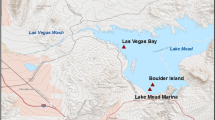Abstract
Freshwater mussels were exposed to several concentrations of DDT [1, 1, 1-trichloro-2, 2-bis-(p-chlorophenyl) ethane] and HEOD (1, 2, 3, 4, 10, 10-hexachloro-6, 7-epoxy-1, 4, 4a, 5, 6, 7, 8a-octahydro-1, 4-endo-exo-5, 8-dimethanonaphthalene principal component of dieldrin) in natural lake water and in reconstituted distilled water, under continuous flow and constant temperature conditions. The mussels concentrate DDT approximately 2400 fold and HEOD 1200 fold in lake water; they concentrated DDT about 1000 fold in distilled water. The concentration of the insecticide chemicals in the mussels reaches equilibrium with the level in the water faster in lake water than in distilled water and the insecticide chemicals have a shorter half-life in the mussels than in lake water. The half-life of HEOD is 4.7 days in lake water compared to 13.6 days for total DDT residues in lake water. The insecticide chemical residue concentrations are highest in the digestive and reproductive tissue, and lowest in the muscle, mantle, and gill tissues. The residue concentrations are very low in the marsupia (abominal pouch), in the tests made in distilled water, but they are almost as great as those in the digestive-and reproductive tissue, in lake water.
Similar content being viewed by others
References
Bedford, J. W., E. W. Roelofs, and M. J. Zabik: The freshwater mussel as a biological monitor of pesticide concentrations in a lotic environment. Limnol. Oceanog.13, 118 (1968).
Bugg, J. C., J. E. Higgins, and E. A. Robertson, Jr.: Chlorinated pesticide levels in the eastern oyster (Crassostrea virginica) from selected areas of the South Atlantic and Gulf of Mexico. Pesticides Monit. J.1, 9 (1967).
Butler, P. A. The problem of pesticides in estuaries. Spec. Publ. No. 3 Amer. Fish. Soc., pp. 154 (1966).
Casper, V. L.: Galveston Bay pesticide study — water and oyster samples analyzed for pesticide residues following mosquito control program. Pesticide Monit. J.1(3), 13 (1967).
Fetterolf, C. M., Jr. and R. B. Willson: Dieldrin and chlordane runoff to Lake Michigan following treatment for Japanese beetle control, Berrien County, Michigan. Proc. 13th Conf. Great Lakes Res.,University of Michigan, Great Lakes Res. Div. (1970).
Gakstatter, J. H. and C. M. Weiss: The elimination of14C-DDT,14C-dieldrin, and14C-lindane from fish following a single sublethal exposure in aquaria. Trans. Amer. Fish. Soc.96(3), 301 (1967).
Godsil, P. J. and W. C. Johnson: Pesticide monitoring of the aquatic biota at Tule Lake National Wildlife Refuge. Pesticides Monit. J.1(4), 21 (1968).
Grzenda, A. R., D. F. Paris, and W. J. Taylor: The uptake, metabolism, and elimination of chlorinated residues by goldfish (Carassius auratus) fed a14C-DDT contaminated diet. Trans. Amer. Fish. Soc.99(2), 385 (1970).
Miller, C. W., B. M. Zuckerman, and A. J. Charig: Water translocation of diazinon-C14 and parathion-S35 off a model cranberry bog and subsequent occurrence in fish and mussels. Trans. Amer. Fish. Soc.95, 345 (1966).
Robeck, G. G., K. A. Dostal, J. M. Cohen, and J. F. Kreissel: Effectiveness of water treatment processes in pesticide removal. J. Amer. Water Works Assn.57, 181 (1965).
Shell Development Co., Modesto, Calif.: Determination of Chlorinated pesticide residues in water, soil, crops, and animal products. Shell Modesto Method Series (1964).
Stickel, L. F.: Crganochlorine pesticides in the environment. Special Scientific Report — Wildlife No. 119,U. S. Department of the Interior Washington, D.C. (1968) 32 pp. (1968).
U. S. Department of the Interior, Washington, D. C.: The effects of pesticides on fish and wildlife. Fish Wildlife Service Circ. No. 226. (1965).
Wilbur, K. M. and C. M. Yonge. Physiology of Mollusca. Volume 2. New York: Academic Press (1966).
Author information
Authors and Affiliations
Rights and permissions
About this article
Cite this article
Bedford, J.W., Zabik, M.J. Bioactive compounds in the aquatic environment: Uptake and loss of DDT and dieldrin by freshwater mussels. Arch. Environ. Contam. Toxicol. 1, 97–111 (1973). https://doi.org/10.1007/BF01986000
Received:
Accepted:
Issue Date:
DOI: https://doi.org/10.1007/BF01986000




